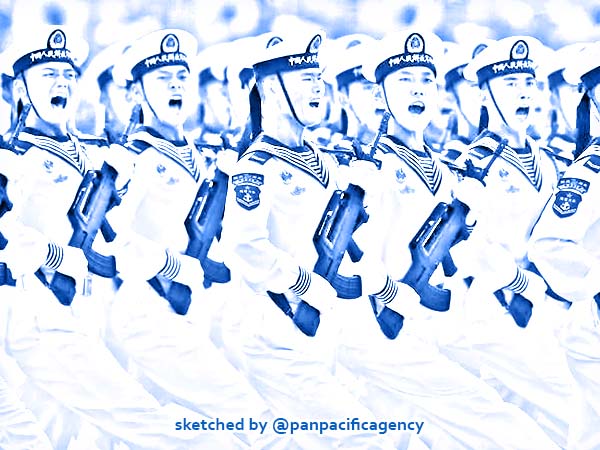[Analytics] China sends 5000 troops to disputed border with India

China's People's Liberation Army showing has engaged in several shows of military might in recent weeks. Picture: Mark Schiefelbein/AP. Source: AP. Sketched by the Pan Pacific Agency.
China’s added a new international border crisis to its growing list. The South China Sea. The East China Sea. Taiwan. Hong Kong. Now there’s serious trouble brewing with India. Punches have been thrown between rival border patrols. Each insists the other had strayed on to their side of the mountainous dividing line between the world’s two most populous nations. Jamie Seidel specially for the News.com.au.
Both sides have responded by massing troops and equipment in the area.
Neither side wants to stand down.
Exactly what is happening in the valley remains uncertain.
Neither Beijing or New Delhi have yet issued an official communique on the evolving crisis.
So military analysts have been relying on unofficial, anonymous reports – and commercial satellite photographs.
What we do know is that Indian and Chinese troops came to physical blows early in May at two strategic sites on the Line of Actual Control (hard border) between the two nations. Things have only escalated since then – despite both sides indicating that “diplomatic channels” were actively pursuing a resolution to the issue.
Border disputes between the two nations are nothing new. They share a 3488km border. Much of it is disputed – including two large regions at the eastern and western extremities.
Many skirmishes have been fought over the decades, including a short war in 1962.
MOVE AND COUNTER MOVE
Indian media claims some 5000 Chinese troops had advanced on five fronts in the nation’s far north, four along the Galwan River and one near Pangong Lake, and have dug-in on territory once considered a kind of “neutral zone”.
“The situation became very volatile … when a scuffle between Indian jawans and the Chinese resulted in detention of some of our jawans but later they were released,” news service NDTV quoted a senior Indian bureaucrat as saying.
Beijing’s state-controlled Global Times news service says the People’s Liberation Army (PLA) had initiated a powerful military response to “India’s illegal trespassing incident”. At the weekend it announced the PLA was going to deploy helicopter drones to closer monitor Indian movements.
These are more than just lines in the sand.
Whoever controls these ridges and gulleys gain far-reaching vantage points. Some offer views deep into India – including over several military facilities.
At the heart of the problem is exactly where the border lies.
After downplaying the border stand-off for 2 weeks, the govt has finally dismissed China’s accusations of the Indian Army crossing the LAC. The PLA intruded into the Indian side of the LAC, disrupted normal patrolling & destroyed posts & bridges on the Galwan Nala at Chang-Chenmo
— Indo-Pacific News (@IndoPac_Info) May 26, 2020
The scene of greatest tension focuses on several ridges reaching into the valley containing Pangong Lake (in India’s Ladakh region). These ridges are designated Fingers 1 through 8.
India claims the border is on Finger 8 (the ridge closest to China). China claims the border is Finger 2 – overlooking the lowlands of India.
Over the decades, the unofficial compromise has been at Finger 4. Both sides had – until now – not sent their border patrols past this point.
But the violent clash was reportedly a Chinese attempt to block Indian road and bridge construction activity along the Galwan Valley, some 200km away, and about 4200m high among the mountains. More than 100 troops were reportedly injured when the two sides resorted to fisticuffs.
TOUGH TALK
India and China aren’t the best of neighbours. Apart from the 1962 war, border skirmishes have been fought in 1967 and 1987. The most recent standoff was at Docklam in 2017.
But their differences go beyond this fencing dispute.
There are repeated diplomatic stoushes over the issue of Nepal and the Dalai Lama. There’s China’s military support of Pakistan. There’s Beijing’s “Belt and Road” trade project moving in on the likes of Ceylon and the Maldives.
Indian foreign policy analyst Narayani Basu told This Week in Asia that rampant speculation about the fresh border clashes was feeding nationalist fervour in both countries.
“We are constantly getting media reports but very little of it is confirmed. This is leading to a lack of clarity and is, in turn, fuelling speculation about where we are heading vis-a-vis the situation on the ground,” she said.
Both both nations have accused the other of serious recent “provocations”. These centre on the construction of military-grade roads leading up to – and through – disputed territory. Meanwhile, India’s military has initiated a policy of “mirroring” Chinese actions in the disputed areas. This involves matching any troop deployment, border surveillance flight or patrol with its own.
“This is an unprecedented situation and hence calls for unprecedented solution-making,” Basu said. “Both countries need to activate backchannel talks and ensure that it is handled delicately.”
Jamie Seidel is a freelance writer